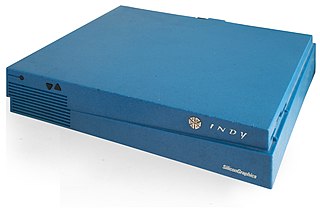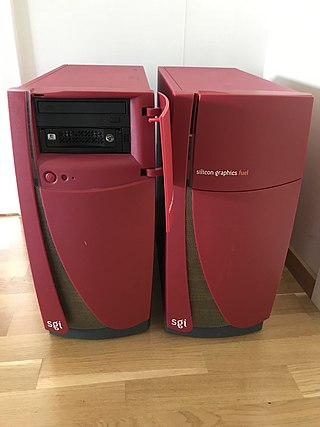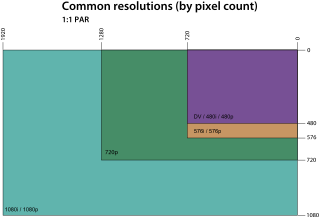
A computer monitor is an output device that displays information in pictorial or textual form. A discrete monitor comprises a visual display, support electronics, power supply, housing, electrical connectors, and external user controls.

Silicon Graphics, Inc. was an American high-performance computing manufacturer, producing computer hardware and software. Founded in Mountain View, California in November 1981 by Jim Clark, its initial market was 3D graphics computer workstations, but its products, strategies and market positions developed significantly over time.

Digital Visual Interface (DVI) is a video display interface developed by the Digital Display Working Group (DDWG). The digital interface is used to connect a video source, such as a video display controller, to a display device, such as a computer monitor. It was developed with the intention of creating an industry standard for the transfer of uncompressed digital video content.

3Dlabs was a fabless semiconductor company. It was founded in 1994 with headquarters in San Jose, California. It originally developed the GLINT and PERMEDIA high-end graphics chip technology, that was used on many of the world's leading computer graphics cards in the CAD and DCC markets, including its own Wildcat and Oxygen cards.
Apple Inc. sold a variety of LCD and CRT computer displays in the past. Apple paused production of their own standalone displays in 2016 and partnered with LG to design displays for Macs. In June 2019, the Pro Display XDR was introduced, however it was expensive and targeted for professionals. Nearly three years later, in March 2022, the Studio Display was launched as a consumer-targeted counterpart to the professional monitor. These two are currently the only Apple-branded displays available.

The display resolution or display modes of a digital television, computer monitor or display device is the number of distinct pixels in each dimension that can be displayed. It can be an ambiguous term especially as the displayed resolution is controlled by different factors in cathode ray tube (CRT) displays, flat-panel displays and projection displays using fixed picture-element (pixel) arrays.

The Indy, code-named "Guinness", is a low-end multimedia workstation introduced on July 12, 1993. Silicon Graphics Incorporated (SGI) developed, manufactured, and marketed Indy as the lowest end of its product line, for computer-aided design (CAD), desktop publishing, and multimedia markets. It competed with Intel x86 computers, and with Windows and Macintosh, including using their files and running their applications via software emulation. It is the first computer to come standard with a video camera, called IndyCam. Indy was repackaged as a server model called Challenge S. Indy was discontinued on June 30, 1997 and support ended on December 31, 2011.

The SGI Fuel is a mid-range workstation developed and manufactured by Silicon Graphics, Inc. (SGI). It was introduced in January 2002, with a list price of US$11,495. Together with the entire MIPS platform, general availability for the Fuel ended on December 29, 2006. An equivalent product for the same market segment was not provided until 2008, when the Virtu product line was introduced, based on x86 microprocessors and Nvidia graphics.
Geometric manipulation of modelling primitives, such as that performed by a geometry pipeline, is the first stage in computer graphics systems which perform image generation based on geometric models. While geometry pipelines were originally implemented in software, they have become highly amenable to hardware implementation, particularly since the advent of very-large-scale integration (VLSI) in the early 1980s. A device called the Geometry Engine developed by Jim Clark and Marc Hannah at Stanford University in about 1981 was the watershed for what has since become an increasingly commoditized function in contemporary image-synthetic raster display systems.

The O2 was an entry-level Unix workstation introduced in 1996 by Silicon Graphics, Inc. (SGI) to replace their earlier Indy series. Like the Indy, the O2 used a single MIPS microprocessor and was intended to be used mainly for multimedia. Its larger counterpart was the SGI Octane. The O2 was SGI's last attempt at a low-end workstation.

The Apple Cinema Display is a line of flat-panel computer monitors developed and sold by Apple Inc. between 1999 and 2011. It was initially sold alongside the older line of Studio Displays, but eventually replaced them. Apple offered 20, 22, 23, 24, 27, and 30-inch sizes, with the last model being a 27-inch size with LED backlighting.

Altix is a line of server computers and supercomputers produced by Silicon Graphics, based on Intel processors. It succeeded the MIPS/IRIX-based Origin 3000 servers.
A thin-film-transistor liquid-crystal display is a variant of a liquid-crystal display that uses thin-film-transistor technology to improve image qualities such as addressability and contrast. A TFT LCD is an active matrix LCD, in contrast to passive matrix LCDs or simple, direct-driven LCDs with a few segments.

SGI Visual Workstation is a series of workstation computers that are designed and manufactured by SGI. Unlike its other product lines, which used the 64-bit MIPS RISC architecture, the line used Intel Pentium II and III processors and shipped with Windows NT 4.0 or Windows 2000 as its operating system in lieu of IRIX. However, the Visual Workstation 320 and 540 models deviated from the architecture of IBM-compatible PCs by using SGI's ARCS firmware instead of a traditional BIOS, internal components adapted from its MIPS-based products, and other proprietary components that made them incompatible with internal hardware designed for standard PCs and hence unable to run other versions of Microsoft Windows, especially Windows 9x. By contrast, the remaining models in the line are standard PCs, using VIA Technologies chipsets, Nvidia video cards, and standard components.

Number Nine Visual Technology Corporation was a manufacturer of video graphics chips and cards from 1982 to 1999. Number Nine developed the first 128-bit graphics processor, as well as the first 256-color (8-bit) and 16.8 million color (24-bit) cards.

DB13W3 (13W3) is a style of D-subminiature connector commonly used for analog video interfaces. The 13 refers to the total number of pins, the W refers to workstation and the 3 refers to the number of high-frequency pins.

OpenLDI is a high-bandwidth digital-video interface standard for connecting graphics/video processors to flat panel LCD monitors. Even though the promoter’s group originally designed it for the desktop computer to monitor application, the majority of applications today are industrial display connections. For example, displays in medical imaging, machine vision, and construction equipment use the OpenLDI chipsets.
IrisVision is an expansion card developed by Silicon Graphics for IBM compatible PCs in 1991 and is one of the first 3D accelerator cards available for the high end PC market. IrisVision is an adaptation of the graphics pipeline from the Personal IRIS workstation to the Micro Channel architecture and consumer ISA buses of most modern PCs of the day. It has the first variant of IRIS GL ported to the PC, predating OpenGL.
The Origin 3000 and the Onyx 3000 is a family of mid-range and high-end computers developed and manufactured by SGI. The Origin 3000 is a server, and the Onyx 3000 is a visualization system. Both systems were introduced in July 2000 to succeed the Origin 2000 and the Onyx2 respectively. These systems ran the IRIX 6.5 Advanced Server Environment operating system. Entry-level variants of these systems based on the same architecture but with a different hardware implementation are known as the Origin 300 and Onyx 300. The Origin 3000 was succeeded by the Altix 3000 in 2004 and the last model was discontinued on 29 December 2006, while the Onyx 3000 was succeeded by the Onyx4 and the Itanium-based Prism in 2004 and the last model was discontinued on 25 March 2005.

The graphics display resolution is the width and height dimension of an electronic visual display device, measured in pixels. This information is used for electronic devices such as a computer monitor. Certain combinations of width and height are standardized and typically given a name and an initialism that is descriptive of its dimensions. A graphics display resolution can be used in tandem with the size of the graphics display to calculate pixel density. An increase in the pixel density often correlates with a decrease in the size of individual pixels on a display.















